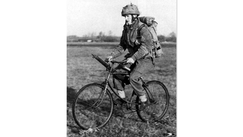 By Dick Martin From its playful origins as a dandy horse for idle Europeans, the bicycle has taken on increasingly serious military applications and for 130 years has remained militarily relevant. In August 1887, the French Scientific journal La Nature noted favorably the role the velocipede, or bicycle, was beginning to play in European military maneuvers. Several European armies fielded bicycle-mounted units during World War I. Originally used to transport ammunition on the battlefield, the first bicycles had no pedals and had to be propelled by the wheelman’s legs. Conceived in 1817 by German Karl Drais, the earliest precursor to the modern bicycle was used as a two and four wheeled version in reconnaissance and patrols. In 1860, the French found commercial uses for the bicycle. By then, it had evolved to include pedals on the front wheel, much like a trike, inflated rubber tires and a chain drive linking central pedals to the rear wheels. Given the improvements, military planners began to consider the bicycle as an alternative conveyance to the horse. The bicycle required neither fodder nor rest and is generally easier to maintain than a horse and much quieter. By the turn of the century, the militaries of all the world’s leading powers were using the bicycle. Its first major test in combat came on the Western Front during the closing days of World War 1. Because of the initial static nature of trench warfare during that war, the bicycle’s mobility was of little use to the warring sides, except in the rear areas, where it was used as messengers or ambulance carriers. However, in the closing stages of the war, when the stalemate broke in August of 1918 during the Allied Offensive known as the “Hundred Days,” the war became much more mobile. During this period, mobility became a primary asset for the bicycle as it was used to conduct patrols, stealth transfer of messages, and rapid movement of military units about the battlefield. During WWII, the Germans took advantage of the bicycles’ fit into their military philosophy, where it became an important part of the blitzkrieg mobility. In Japan, thousands of bicycle troops were used in its 1937 invasion of China as well as relying on them in their 1942 invasion of Singapore. Across Britain, airfields used the bicycle to quickly move air crews to their waiting planes. During the Vietnam War, the bicycle was used as a key logistical resource for North Vietnam regulars moving supplies along the Ho Chi Minh Trail, the main route for bringing supplies into South Vietnam. Bicycles have been common throughout Vietnam since the early 1900s and continue to be used there for personal transportation as well as for haulage. The bicycle has played a role in irregular warfare during the far-flung wars of the 20th century. In recent decades, irregular forces in the Middle East have even weaponized the bicycle. In 2006, a successful NATO operation was marred when a suicide bomber using a bicycle killed four foot soldiers. The bicycle has also been used as a lethal weapon by the IRA in Northern Ireland. Far from fading into irrelevance during it third century as a conveyance, the bicycle continues to be an integral part of warfare. Needing neither fuel nor fodder, faster and quieter than man afoot, it will continue to find military application. Edited from an article “Wheels of War” found in the July 2020 edition of the magazine “Military History.”
1 Comment
Daryl Heusinkveld
8/21/2020 20:02:04
Great Story Dick!
Reply
Leave a Reply. |
Categories
All
Archives
October 2023
|